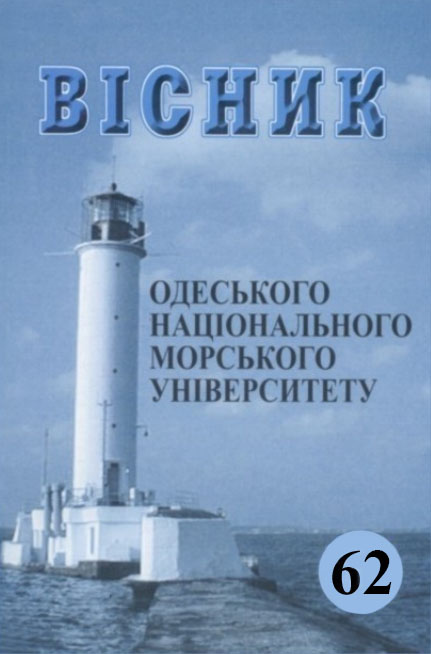Determination of pressure distribution in the non-newton oil ball in ship energy plant
Main Article Content
Abstract
The durability and reliability of ship power plants are directly related to the processes of wear and heat generation that occur in sliding pairs. The processes of wear and heat release are decisive influenced by the lubricating layer in the contact zone of the sliding pairs. The presence of lubricating layer and its characteristics are related, on one side with operating modes of sliding pair, and on the other side with properties of engine oil. In this case, the determination of the technical condition of the sliding pairs (bearings, crankshaft, piston rings, cylinder bushing) is related with short-term or long-term decommissioning of the engine. At the same time, theoretical studies, the use of which makes it possible to evaluate the operational parameters of the lubricant, which separates the surfaces of the sliding pairs, as well as the loads that apply to the contact areas of these surfaces relate to Newtonian oils. At the same time, the rheological characteristics of the oils are considered constant and does not take into account changes in viscosity, sliding loads and other indicators. This results in false values in determining the contact stresses and pressures that occur in sliding pairs (under high dynamic loads) can contribute to their increased or critical wear. Therefore, research into the properties of lubricating layers in sliding pairs for non-Newtonian oils is an important theoretical and application task. The problem of determining the pressure in the lubricating layer, the sliding pair, of a ship's power plants, is formulated as a boundary value problem for the Reynolds differential equation. An exact solution to this problem was obtained for non-Newtonian oils, which made it possible to determine the specific pressure distribution in the lubricating layer of the sliding pair. A number of important regularities of said distribution are revealed, in particular, dependence of maximum pressure value on radial gap and eccentricity in sliding pair. In particular, at constant value of relative radial clearance with increase of value of relative eccentricity of pressure value increases in the lubricating layer, at that length of working layer decreases, and angle, at which maximum value of pressure is reached, shifts to end of working zone. At constant values of relative eccentricity at increase of relative radial clearance, value of pressure in oil layer decreases, and length of contact spot practically does not change. In all cases, at the maximum pressure, the thickness of the oil layer is sufficiently small and, therefore, the role of the surface lubricating film is significantly increased.
Article Details
References
2. Xrulev, A.E. (2018). Vlyyanye neyspravnostej v systeme smazky na xarakter povrezhdenyya podshypny`kov DVS [The effect of malfunctions in the lubrication system on the nature of damage to ICE bearings]. Dvygately vnutrennego sgoranyya, vol. 1, pp. 74-81. DOI: 10.20998/0419-8719.2018.1.1.
3. Sagin, S.V., Solodovnikov, V.G. (2017). Estimation of Operational Properties of Lubricant Coolant Liquids by Optical Methods. International Journal of Applied Engineering Research, vol. 12, no. 19, pp. 8380-8391.
4. Zablotsky, Yu.V. (2015). Yspolzovanye regulyarnogo mykrorelefa dlya optymyzacyy raboty toplyvnoj apparatury vysokogo davlenyya sudovyx dyzelej [Using regular microrelief to optimize the operation of high-pressure fuel equipment of marine diesel engi-nes]. Sudovye energeticheskie ustanovki: nauchno-tehnicheskij sbornik, no. 36, pp. 65-73.
5. Sagin, S.V., Semenov, O.V. (2015). Ocenka vyazkosty masla pry obespechenyy rezhymov smazyvanyya cylyndrovoj gruppy sudovyx dyzelej [Assessing the viscosity of oil while providing lubrication modes for the cylinder group of marine diesel engines] Sudovye energeticheskie ustanovki: nauchno-tehnicheskij sbornik, no. 36, pp. 104-114.
6. Kryvyi, M.А. (2017). Obespechenye rezhymov smazyvanyya pod-shypnykovyx uzlov malooborotnyx dyzelej pry rezhymax puska y reversa [Providing lubrication modes for bearing assemblies of low-speed diesel engines under starting and reverse modes]. Sud-nova energetyka: stan ta problemy: Materialy VIII Mizhnarodnoyi naukovo-texnichnoyi konferenciyi. – Mykolayiv: Nacionalny juni-versytet korablebuduvannya, pp. 74-78.
7. Sagin, S.V., Kuropyatnyk, О.А. (2018). The Use of Exhaust Gas Recirculation for Ensuring the Environmental Performance of Ma-rine Diesel Engines. OUR SEA: International Journal of Maritime Science & Technology, vol. 65, no 2, pp. 78-86. doi.org/10.17818/ NM/ 2018/2.3.
8. Kryvyi, M.O. (2017). Osoblyvosti reologiyi motornyx mastyl pry zabezpechenni rezhymiv zmashhennya par tertya sudnovyx malo-obertovyx dyzeliv [Special rheology of motor skills in secure modes of steam wiping the ship with low speed diesel engines]. Materialy naukovo-texnychnoyi konferenciyi «Richkovyj ta morskyj flot: ekspluataciya i remont», Odesa: NU «OMA», pp. 31-34.
9. Sagin, S.V., Semenov, O.V. (2016). Motor Oil Viscosity Stratifica-tion in Friction Units of Marine Diesel Motors. American Journal of Applied Sciences, vol. 13, iss. 2, pp. 200-208. DOI: 10.3844/ ajassp. 2016.200.208.
10. Sagin, S.V., Semenov, O.V. (2016). Marine Slow-Speed Diesel En-gine Diagnosis with View to Cylinder Oil Specification. American Journal of Applied Sciences, vol. 13, no. 5, pp. 618-627. DOI: 10.3844/ajassp.2016.618.627.
11. Kryvyi, M.O. (2019). Matematychna model mastylnogo sharu v parax kovzannya v sudnovyx energetychnyx ustanovkax [Mathe-matical model of lubricating layer in sliding vapors in ship power plants]. Materialy Mizhnarodnoyi naukovo-texnichnoyi konferencij «Sudnova elektroinzheneriya, elektronika i avtomatyka», Odesa, NU «OMA», pp. 144-148. dx.doi.org/ 10.31653/2706-7874.
12. Kryvyi, M.A. (2018). Yssledovanye yavlenyya stratyfykacyy vyaz-kosty motornogo masla v uzlax trenyya sudovyx dyzelej. Suchasni informacijni ta innovacijni texnologiyi na transporti: Materialy` X Mizhnarodnoyi naukovo-prakty`chnoyi konferenciyi MINTT-2018, Xerson: Xersonska derzhavna morska akademiya, pp. 321-324.
